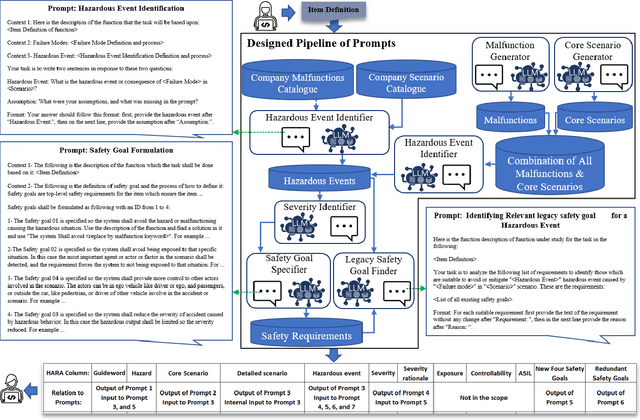Hȧkan Sivencrona
Engineering Safety Requirements for Autonomous Driving with Large Language Models
Mar 24, 2024



Abstract:Changes and updates in the requirement artifacts, which can be frequent in the automotive domain, are a challenge for SafetyOps. Large Language Models (LLMs), with their impressive natural language understanding and generating capabilities, can play a key role in automatically refining and decomposing requirements after each update. In this study, we propose a prototype of a pipeline of prompts and LLMs that receives an item definition and outputs solutions in the form of safety requirements. This pipeline also performs a review of the requirement dataset and identifies redundant or contradictory requirements. We first identified the necessary characteristics for performing HARA and then defined tests to assess an LLM's capability in meeting these criteria. We used design science with multiple iterations and let experts from different companies evaluate each cycle quantitatively and qualitatively. Finally, the prototype was implemented at a case company and the responsible team evaluated its efficiency.
Welcome Your New AI Teammate: On Safety Analysis by Leashing Large Language Models
Mar 14, 2024Abstract:DevOps is a necessity in many industries, including the development of Autonomous Vehicles. In those settings, there are iterative activities that reduce the speed of SafetyOps cycles. One of these activities is "Hazard Analysis & Risk Assessment" (HARA), which is an essential step to start the safety requirements specification. As a potential approach to increase the speed of this step in SafetyOps, we have delved into the capabilities of Large Language Models (LLMs). Our objective is to systematically assess their potential for application in the field of safety engineering. To that end, we propose a framework to support a higher degree of automation of HARA with LLMs. Despite our endeavors to automate as much of the process as possible, expert review remains crucial to ensure the validity and correctness of the analysis results, with necessary modifications made accordingly.
 Add to Chrome
Add to Chrome Add to Firefox
Add to Firefox Add to Edge
Add to Edge